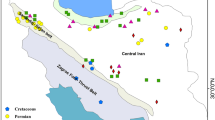Abstract
Previously, little attention has been paid to terrestrial radioisotopes (U, Th, 40K) occurring in manganese ores, despite the fact that the biogeochemical relationship between Mn and U is versatile. Occurrence of terrestrial radioisotopes in great amounts during mining on a long-term causes significant radiation exposure. It is important to inspect black shale-hosted manganese ores from this aspect, as black shales are typically potential U-rich formations. Despite the increased radon concentration in the mine, based on the detailed major elements, trace elements and gamma spectroscopy inspection of the rock types of deposit, the U, Th enrichment was undetectable. However, the U and Th content of about average terrestrial abundance of the great ore amount may be in the background of the increased radon concentration level. This Mn-carbonate ore deposit in spite of the low U content exhibit potential radon danger for miners, which can be eliminated with intensive air change only.
Similar content being viewed by others
References
Abel-Ghany, H.A. (2010), Natural activities of 238U, 232Th, and 40K in manganese ore, Am. J. Environ. Sci. 6,1, 90–94, DOI: 10.3844/ajessp.2010.90.94.
Aller, R.C., and P.D. Rude (1988), Complete oxidation of solid phase sulphides by manganese and bacteria in anoxic marine sediments, Geochim. Cosmochim. Acta 52,3, 751–765, DOI: 10.1016/0016-7037(88)90335-3.
Breitner, D., T. Turtiainen, H. Arvela, P. Vesterbacka, B. Johanson, M. Lehtonen, K.-H. Hellmuth, and C. Szabó (2008), Multidisciplinary analysis of Finnish esker sediment in radon source identification, Sci. Total. Environ. 405,1–3, 129–139, DOI: 10.1016/j.scitotenv.2008.06.015.
Cote, P., and M.G. Townsend (1981), Mixtures of radon and thoron daughters in underground atmospheres, Health Phys. 40,1, 5–17, DOI: 10.1097/00004032-198101000-00002.
Cuney, M., and K. Kyser (2008), Recent and Not-so-recent Developments in Uranium Deposits and Implications for Exploration, Mineralogical Association of Canada, Short Course Series, Vol. 39.
Darby, S.C., E. Whitely, G.R. Howe, S.J. Hutchings, R.A. Kusiak, J.H. Lubin, H.I. Morrison, M. Tirmarche, L. Tomásek, E.P. Radford, R.J. Roscoe, J.M. Samet, and S.X. Yao (1995), Radon and cancers other than lung cancer in underground miners: a collaborative analysis of 11 studies, J. Natl. Cancer Inst. 87,5, 378–384, DOI: 10.1093/jnci/87.5.378.
Grasselly, G., and G. Pantó (1988), Rare Earth elements in the manganese deposit of Úrkút (Bakony Mountains, Hungary), Ore Geol. Rev. 4,1–2, 115–124, DOI: 10.1016/0169-1368(88)90007-8.
Kaeding, L, O. Brockamp, and H. Harder (1983), Submarin-hydrothermale Entstehung der Sedimentären Mangan-Lagerstätte Úrkút (Ungarn), Chem. Geol. 40,3–4, 251–268, 10.1016/0009-2541(83)90032-3 (in German).
Kávási, N., C. Németh, T. Kovács, S. Tokonami, V. Jobbágy, A. Várhegyi, Z. Gorjánácz, T. Vigh, and J. Somlai (2007), Radon and thoron parallel measurements in Hungary, Radiat. Prot. Dosim. 123,2, 250–253, DOI: 10.1093/rpd/ncl102.
Kávási, N., J. Somlai, T. Vigh, S. Tokonami, T. Ishikawa, A. Sorimachi, and T. Kovács (2009), Difficulties in the dose estimate of workers originated from radon and radon progeny in a manganese mine, Radiat. Meas. 44,3, 300–305, DOI: 10.1016/j.radmeas.2009.03.014.
Kelly, S.D. (2010), Uranium chemistry in soils and sediments. In: A. Hartemink and A. McBratney (eds.), Developments in Soil Science, Vol. 34, Elsevier Press, Amsterdam, 411–466, DOI: 10.1016/S0166-2481(10)34014-1.
Laznicka, P. (1992), Manganese deposits in the global lithogenetic system: Quantitative approach, Ore Geol. Rev. 7,4, 279–356, DOI: 10.1016/0169-1368(92) 90013-B.
Mason, B.H. (1958), Principles of Geochemistry, 2nd ed., John Wiley and Sons, New York.
OECD/NEA-IAEA (2008), Uranium 2007: Resources, Production and Demand, Red Book, OECD, Paris.
Polgári, M. (1993), Manganese Geochemistry Reflected by Black Shale Formation and Diagenetic Processes: Model of Formation of the Carbonatic Manganese Ore of Úrkút, Special Series of Hungarian Geological Institute, Karpati Publish House, Ushgorod, 211 pp.
Polgári, M., Z. Szabó, and T. Szederkényi (eds.) (2000), Manganese ores in Hungary. In Commemoration of Professor Gyula Grasselly, Juhász Publishing House, Szeged, 675 pp.
Polgári, M., M. Szabó-Drubina, and J.R. Hein (2003), Phosphogenesis in Jurassic black shale-hosted Mn-carbonate deposits, Úrkút and Eplény, Hungary, Investigations on archive sample drillcore Úrkút-136, Bull. Hung. Geol. Surv. 133,1, 37–48.
Polgári, M., J.R. Hein, T. Vigh, M. Szabó-Drubina, I. Fórizs, L. Bíró, A. Müller, and A.L. Tóth (2012), Microbial processes and the origin of the Úrkút manganese deposit, Hungary, Ore Geol. Rev. 47, 87–109, DOI: 10.1016/j.oregeorev.2011.10.001.
Roy, S. (1988), Manganese metallogenesis: A review, Ore Geol. Rev. 4,1–2, 155–170, DOI: 10.1016/0169-1368(88)90011-X.
Segev, A. (1992), Remobilization of uranium and associated metals through karstification processes: A case study from the Timna Formation (Cambrian), Southern Israel, Ore Geol. Rev. 7,2, 135–148, DOI: 10.1016/0169-1368(92)90009-A.
Szabó, I.M. (1989), Microbiology of Biosphere, Akadémiai Kiadó, Budapest (in Hungarian).
Tirmarche, M., A. Raphalen, F. Allin, J. Chameaud, and P. Bredon (1993), Mortality of a cohort of French uranium miners exposed to relatively low radon concentrations, Br. J. Cancer. 67,5, 1090–1097, DOI: 10.1038/bjc.1993.200.
Trueman, C.N., and N. Tuross (2002), Trace elements in recent and fossil bone apatite, Rev. Mineral Geochem. 48,1, 489–521, DOI: 10.2138/rmg.2002.48.13.
Varentsov, I.M., G., Grasselly, and Z. Szabó (1988), Ore-formation in the early-Jurassic basin of Central-Europe: Aspects of mineralogy, geochemistry, and genesis of the Úrkút manganese deposit, Hungary, Chem. Erde — Geochem. 48, 257–304.
Weiszburg, T.G., E. Tóth, and A. Beran (2004), Celadonite, the 10-Å green clay mineral of the manganese carbonate ore, Úrkút, Hungary, Acta Mineral. Petrogr. 45,1, 65–80.
Wignall, P.B. (1994), Black Shales, Clarendon Press, Oxford.
Author information
Authors and Affiliations
Corresponding author
Rights and permissions
About this article
Cite this article
Vigh, T., Kovács, T., Somlai, J. et al. Terrestrial radioisotopes in black shale hosted Mn-carbonate deposit (Úrkút, Hungary). Acta Geophys. 61, 831–847 (2013). https://doi.org/10.2478/s11600-013-0124-2
Received:
Revised:
Accepted:
Published:
Issue Date:
DOI: https://doi.org/10.2478/s11600-013-0124-2




